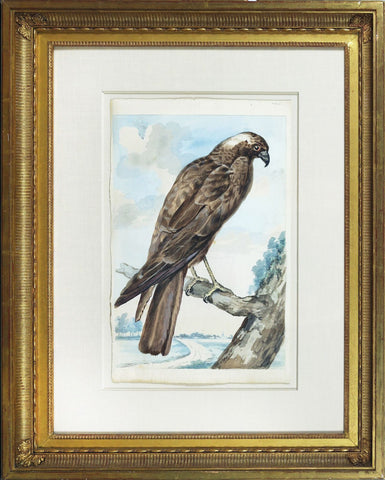![Samuel Howitt (British, 1765-1822), Bucerus Abyssinia [Hornbill from Africa and Asia]](http://aradergalleries.com/cdn/shop/products/howitt_BucerusAbyssiniaHornbillfromAfricaandAsia_large.jpg?v=1605824351)
Samuel Howitt (British, 1765-1822), Bucerus Abyssinia [Hornbill from Africa and Asia]
Samuel Howitt (British, 1765-1822)
Bucerus Abyssinia [Hornbill from Africa and Asia]
Signed ‘Howitt; l.r.
Watercolor and pencil on paper
ca. 1811
Paper size: 7 1/8 x 4 7/16 in.
Mount size: 10 x 7 1/2 in.
Samuel Howitt (British, 1765-1822)
As a young man, Samuel Howitt had a very carefree nature. This lifestyle brought financial obligations, which he tried to meet as an artist. In reaction to his stable Quaker upbringing, Howitt was an active participant in the thriving London social scene of gambling, hunting, fishing, and sporting. He was not alone in his rounds of London’s drinking houses. His brother-in-law, the noted caricaturist and watercolorist, Thomas Rowlandson, joined him. Samuel’s marriage to Rowlandson’s sister was not a success, and apparently, his passion for fishing and sporting excursions led to their separation.
Howitt’s initial artistic efforts were somewhat crude, but his natural talents quickly and skillfully progressed to a remarkable degree. He exhibited at the Royal Academy between 1783 and 1815. His quick fretted outlines reflect the influence of Rowlandson. He was prolific in oil and watercolor, and as a printmaker and his lighthearted works appeared in numerous sporting and other publications. In 1808, he provided illustrations for The Angler’s Manual. In 1812, seventy of his images appeared in the British Sportsman, and later a large group appeared in The Old Sporting Magazine.
However, Howitt’s best-known work is Oriental Field Sports, a collection of forty beautiful and dramatic aquatints drawn by Howitt after the original sketches of his friend Captain Thomas Williamson. The book’s primary purpose was to explicate and illustrate the excitement and peculiarities of Indian game hunting, both big and small. Williamson had explored Bengal’s innermost regions in search of the exotic Asian prize, and from his sketches, Howitt produced some of the most prized images of big-game hunting.
His habit of drawing animals from life at the Tower of London was the basis of the 1811 A New Work of Animals, fifty-six carefully executed designs based on the fables of Aesop. Likely, the Tower of London was also the source for many of the watercolors of animals and birds here presented. However, Bullock’s notation on some would indicate that he also used specimens from this renowned dealer in animal skins.
The companion album to the collection is now in London’s Natural History Museum and forms part of the famed banker’s holdings, Baron Rothschild of Tring. Rothschild was a keen amateur scientist and, from the age of seven, started collecting specimens. He founded the Zoological Museum at Tring, opening it to the public in 1892. Moreover, he wrote several articles on ornithology and held distinguished positions as Trustee of the Natural History Museum, Chairman of the British Ornithologists’ Club (1913-1918), and President of the British Ornithologist’s Union (1923-1928).
It is not certain when the two albums of Howitt’s drawings were divided, and thus difficult to establish a definite provenance to the Rothschild collection for the set pictured here. However, they are fine examples of one of the leading natural history painters of the late eighteenth and early nineteenth centuries.
or by email at loricohen@aradergalleries.
We Also Recommend





